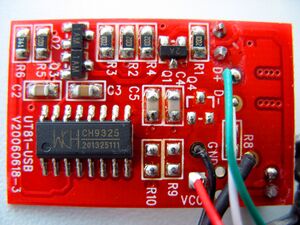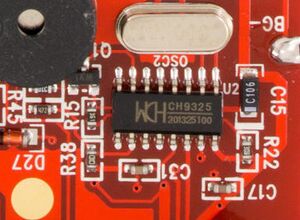WCH CH9325


WCH, also known as Nanjing Qin Heng Electronics, makes a series of microcontrollers, PCI interface chips, and USB interface chips.
The CH9325 is a USB interface chip, which converts data received via UART to USB and vice versa. The chip presents a HID (Human Interface Device) USB profile, in an effort to not require USB driver installation: this is typically handled by the OS kernel. An example of the profile, in Linux 'lsusb' output format, is here.
The chip runs off of a 12MHz oscillator.
Pin layout
| RESET | 1- | O | -16 | |
| UART TX | 2- | -15 | VCC +5V | |
| UART RX | 3- | -14 | ||
| TX ACT | 4- | -13 | ||
| VCC select | 5- | -12 | ||
| USB D+ | 6- | -11 | ||
| USB D- | 7- | -10 | OSC+ | |
| GND | 8- | -9 | OSC- |
Pin 4 goes high while transmitting data on UART TX (i.e. USB -> device). This is possibly intended for an activity LED.
Assuming pin 5 (VCC select) has the same function as other WCH devices (such as CH341), tying it to GND via a decoupling capacitor selects +5V external power operation. Tying the pin to 3.3V selects 3.3V external power.
Protocol
Chip configuration
USB packets sent to endpoint 0 are intercepted by the chip, and serve to configure it. A confguration packet consists of (at least) 2 bytes:
| Byte | Description |
|---|---|
| 1-2 | UART baudrate, in little-endian order. For example, 60 09 = 0x0960 = 2400. Supported baudrates are 2400, 4800, 9600 and 19200; setting any other rate defaults to 2400 instead.
|
| 3, 4 | uncertain purpose, probably parity and stop bits specs, often omitted, or 0x00 is sent |
| 5 | number of data bits (encoded, values 0-3 translate to 5-8 data bits) |
Applications can get away with just sending the first two bytes. Vendor software has been observed sending 3 more bytes (00 00 03), but these seem to be not strictly required.
Even though the chip defaults to 2400 baud, that is not the default on startup: the baudrate setting command MUST still be sent.
USB encapsulation
The chip stores bytes received via the UART RX pin into a buffer. It transfers the contents of the buffer to a HID packet at regular intervals (maximum 12ms). The HID packets are always 8 bytes long, with the first byte containing the number of payload bytes. This is encoded as 0xf0 + length. The next 7 bytes contain the payload, padded with zeroes. Thus, even if no data is ever received on the UART, the chip always sends at least one packet every 12ms containing:
f0 00 00 00 00 00 00 00
Here's a packet with 2 bytes payload:
f2 35 41 00 00 00 00 00
Extracting the UART stream on the other side of the USB bus simply entails the reverse process: for every received packet, extract the payload according to the length byte (nibble).
Transmit data is communicated in similar ways: The first byte contains the number of payload bytes which follow (without 0xf0 added as is the case for receive data). Up to 7 payload bytes follow. The complete block consists of exactly 8 bytes, with 0x00 padded when necessary.